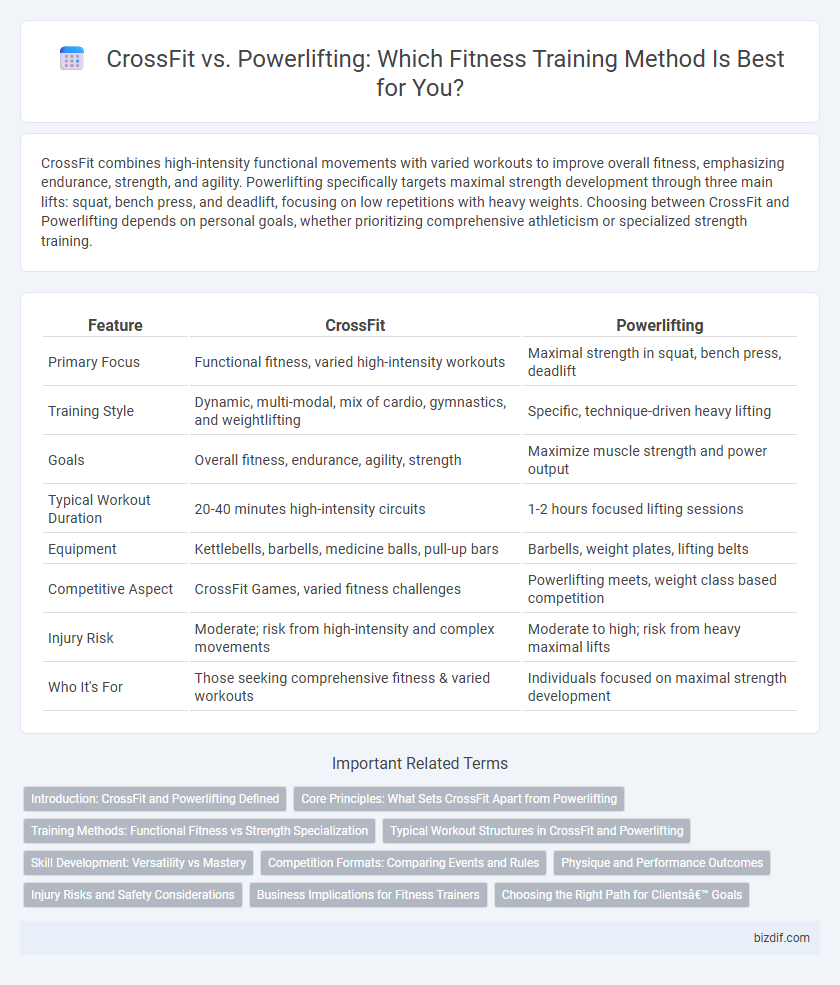CrossFit combines high-intensity functional movements with varied workouts to improve overall fitness, emphasizing endurance, strength, and agility. Powerlifting specifically targets maximal strength development through three main lifts: squat, bench press, and deadlift, focusing on low repetitions with heavy weights. Choosing between CrossFit and Powerlifting depends on personal goals, whether prioritizing comprehensive athleticism or specialized strength training.
Table of Comparison
| Feature | CrossFit | Powerlifting |
|---|---|---|
| Primary Focus | Functional fitness, varied high-intensity workouts | Maximal strength in squat, bench press, deadlift |
| Training Style | Dynamic, multi-modal, mix of cardio, gymnastics, and weightlifting | Specific, technique-driven heavy lifting |
| Goals | Overall fitness, endurance, agility, strength | Maximize muscle strength and power output |
| Typical Workout Duration | 20-40 minutes high-intensity circuits | 1-2 hours focused lifting sessions |
| Equipment | Kettlebells, barbells, medicine balls, pull-up bars | Barbells, weight plates, lifting belts |
| Competitive Aspect | CrossFit Games, varied fitness challenges | Powerlifting meets, weight class based competition |
| Injury Risk | Moderate; risk from high-intensity and complex movements | Moderate to high; risk from heavy maximal lifts |
| Who It's For | Those seeking comprehensive fitness & varied workouts | Individuals focused on maximal strength development |
Introduction: CrossFit and Powerlifting Defined
CrossFit is a high-intensity fitness training program that combines elements of weightlifting, cardiovascular exercises, and functional movements to enhance overall fitness, strength, and endurance. Powerlifting is a strength sport focused on three main lifts: squat, bench press, and deadlift, emphasizing maximal strength development. Both disciplines require dedication and proper technique, but CrossFit offers a broader fitness approach while Powerlifting targets specific strength gains.
Core Principles: What Sets CrossFit Apart from Powerlifting
CrossFit emphasizes functional movements performed at high intensity across varied workouts, combining elements of weightlifting, gymnastics, and cardiovascular training. Powerlifting focuses specifically on maximal strength in three lifts: squat, bench press, and deadlift, aiming for the highest possible weight in each. CrossFit's constantly varied training and emphasis on overall fitness differentiate it from powerlifting's specialization in raw strength development.
Training Methods: Functional Fitness vs Strength Specialization
CrossFit training emphasizes functional fitness by incorporating varied, high-intensity movements that enhance overall endurance, agility, and mobility. Powerlifting focuses on strength specialization through low-repetition, high-weight lifts targeting the squat, bench press, and deadlift to maximize muscular strength. Both methods provide distinct adaptations, with CrossFit promoting broad physical competency and Powerlifting concentrating on maximal power output.
Typical Workout Structures in CrossFit and Powerlifting
CrossFit workouts typically involve varied functional movements performed at high intensity, combining elements of weightlifting, gymnastics, and cardiovascular exercises in a circuit or AMRAP (As Many Rounds As Possible) format. Powerlifting training centers on three main lifts--squat, bench press, and deadlift--emphasizing maximal strength with low-repetition sets and longer rest periods between sets. CrossFit incorporates constantly varied workouts that target overall fitness, whereas powerlifting focuses on progressive overload to increase maximal strength in specific lifts.
Skill Development: Versatility vs Mastery
CrossFit emphasizes skill development through versatility, incorporating diverse movements that enhance overall functional fitness and adaptability in various physical tasks. Powerlifting targets mastery by focusing intensely on perfecting three core lifts--squat, bench press, and deadlift--building maximal strength and technique precision. This contrast highlights CrossFit's broad athletic skill set versus powerlifting's specialized strength expertise.
Competition Formats: Comparing Events and Rules
CrossFit competitions feature varied events combining weightlifting, gymnastics, and high-intensity cardio, with athletes tested on endurance, strength, and skill across multiple workouts, often scored by time or repetitions completed. Powerlifting competitions focus on three standardized lifts: squat, bench press, and deadlift, with athletes aiming for maximum weight in each lift under strict technical rules and judging criteria. The scoring in powerlifting is based solely on the highest successful lift total, whereas CrossFit uses cumulative scoring across diverse challenges to determine overall rankings.
Physique and Performance Outcomes
CrossFit enhances overall athleticism by combining high-intensity functional movements, boosting cardiovascular endurance, strength, and muscular endurance for a well-rounded physique. Powerlifting focuses on maximal strength development in the squat, bench press, and deadlift, leading to increased muscle mass and power with a more specialized muscular build. Performance outcomes in CrossFit emphasize versatility and metabolic conditioning, while powerlifting prioritizes maximal force output and neuromuscular adaptation.
Injury Risks and Safety Considerations
CrossFit and powerlifting each present distinct injury risks due to their varying training methodologies, with CrossFit's high-intensity, varied movements increasing the likelihood of acute injuries like strains and sprains, while powerlifting's repetitive maximal lifts primarily risk overuse injuries such as tendonitis and joint stress. Proper technique, gradual progression, and individualized coaching are critical in minimizing injury risk in both disciplines. Implementing adequate warm-ups, mobility work, and recovery protocols further enhances safety and performance longevity for athletes engaged in CrossFit or powerlifting.
Business Implications for Fitness Trainers
CrossFit offers fitness trainers a scalable business model with community-driven classes and diverse programming that attracts a broad client base seeking functional fitness and high-intensity workouts. Powerlifting coaching emphasizes specialized training, appealing to niche markets focused on strength development and competitive lifting, which can result in higher-priced, individualized sessions. Trainers must weigh the consistent revenue potential from CrossFit memberships against the premium pricing opportunities and client loyalty found in powerlifting specialty services.
Choosing the Right Path for Clients’ Goals
CrossFit offers a dynamic blend of aerobic conditioning, weightlifting, and high-intensity interval training aimed at overall fitness and functional strength, making it ideal for clients seeking versatility and endurance. Powerlifting centers on maximizing strength in the squat, bench press, and deadlift, providing measurable progress for those focused on peak strength development. Selecting the appropriate path depends on a client's specific goals, whether prioritizing broad fitness adaptability or targeted power gains.
CrossFit vs Powerlifting Infographic

 bizdif.com
bizdif.com